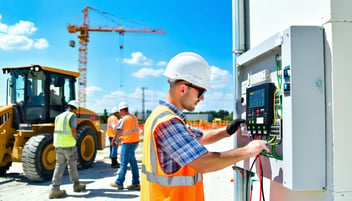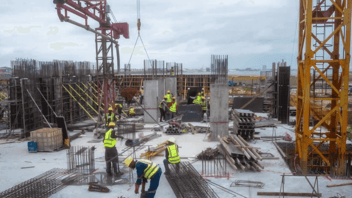The construction industry is infamous for being among the most hazardous sectors to work in.
Accidents in construction sites are demotivating to the workers and affect the bottom line of any project.
According to OSHA, 50% of site accidents are due to the fatal four: falls, people struck by objects, electrocution, and people caught-in/between equipment. Your site can be different. Having a safety culture significantly reduces the risk of the fatal four at your construction site. And as it is in our homes, culture begins with a set of rules. These rules are not adhered to by compulsion. But out of a desire to keep oneself and everyone else safe and improve workplace safety factors. Here are simple construction site safety rules you can use to promote safety at your site.
Rule #1 Create Awareness
The biggest source of danger at a construction site is an ignorant worker. Before any worker gets down to work, they should be aware of the hazards and safety measures. By informing them about what could go wrong, workers become more alert. They also appreciate the need for safety, take precautions, and know how to respond to accidents.
Ensure safety is a priority during the induction and ongoing training of your team members. But it should not stop in the training room. Site supervisors and experienced workers should continue to educate new staffers on safety while on the job. They should be ‘their brothers' keepers.’ The objective is to make everyone aware of the safety precautions and correctly implement them.
Rule #2 Wear Protective Gear At All Times
There is a reason why it is called protective gear - it is your last line of defense if you come in contact with a hazard. The most common protective gear in construction sites includes safety boots, hard hats, gloves for hand protection, goggles or eye protection, a face mask, and high visibility jacket.
Workers in a construction site should have these on at all times. However, depending on the task and environment, a worker may require additional protective gear. Make sure all site workers wear appropriate protective attire at all times.
Rule #3 Keep The Site Tidy
Two of OSHA's fatal four often arise due to untidy workplaces - falls and being struck by objects. Building work is messy, but construction sites do not have to be. By keeping tidy, you can avoid slips, trips, and falls.
Every worker should maintain a tidy workspace throughout their shift. It should be without clutter and well arranged. Store tools, materials, and equipment correctly. As a manager of a construction site, ensure that there are garbage receptacles or trash bins placed regularly throughout the site. Access routes, especially to emergency exits, should not have any obstruction.
Rule # 4 Follow The Correct Procedure
Every task at the site should have a procedure, which includes safety, and team members should follow these procedures when working. They should also be readily available for reference and explained during training sessions. But more than that, new workers will need help and time to get accustomed to following the correct procedures. Management and site supervisors should organize regular safety talks to help nurture a mindset of following procedures.
Rule #5 Use The Right Tools And Equipment
It is almost impossible to consider construction work without talking about tools and equipment.
Just as there are people with different trade skills on a site, you require various tools and equipment. Using one tool for multiple jobs is not only inefficient but also could be hazardous.
Accidents such as electrocution in construction sites often happen when workers use incorrect tools. For example, a worker who uses 110v equipment on a 240v rated source could get injured. Other hazards include over-exertion and risk of breakage.
Site managers should always avail correct tools and equipment and ensure workers know how to use them.
Rule # 6 Report Malfunctions And Near Misses
It is great to have many tools on site. However, if they are faulty, they become a danger to workers. When workers use faulty tools and equipment, they risk hurting themselves, other people, and overexerting.
Set up a rule: Do not use faulty equipment or tools. Instead, promptly inform the supervisor about it. On the other hand, near misses should not go undocumented. They provide valuable learning opportunities.
By reporting any equipment malfunctions and near misses, workers contribute to improving site safety. Management can repair or restore broken-down equipment and use lessons learned from the near misses to take measures to prevent accidents.
Rule # 7 Ask Whenever In Doubt
Finally, every construction site should have this rule. If you don’t understand or you are not sure about a task, ask.
It is better to be safe than sorry. Site workers should clarify the procedure, express concerns and doubts, or understand how to execute tasks correctly. This could be the golden rule that reduces hazards in your construction site. As we mentioned in the opener, the biggest danger in a construction site is an ignorant worker. By asking and encouraging others to ask, you know more, and construction sites are safer.
If you're eager to discover how Ving can enhance safety and compliance in your workplace, we invite you to complete the form below. Our team will promptly reach out to you to schedule an exploratory conversation.






Leave a Comment